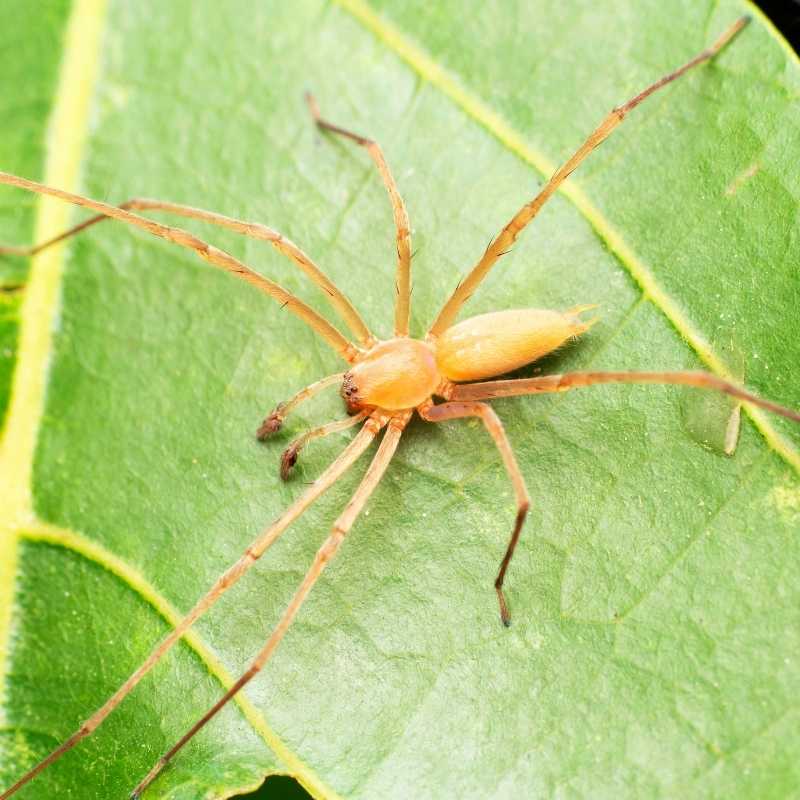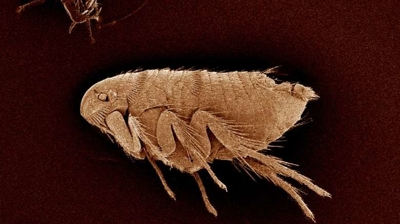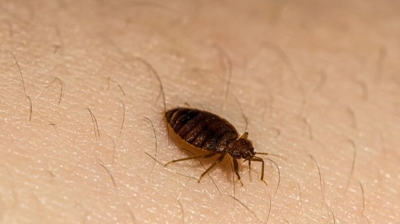
Sac Spiders

Are Sac Spiders Harmful?
Sac spiders (Cheiracanthium spp.) are generally not considered harmful to humans, and their bites are usually of low medical significance. However, there are a few ways in which they could be considered potentially problematic:
- Bites: Sac spiders are venomous, and their bites can cause localized pain, redness, swelling, and itching. In some cases, a small blister may form at the bite site. While the symptoms are generally mild and self-limiting, individual reactions can vary, and some people may experience more pronounced discomfort.
- Allergic Reactions: Although rare, some individuals may be allergic to spider venom, and their reactions can be more severe. Allergic reactions may include extensive swelling, rash, and, in very rare cases, systemic symptoms like nausea, fever, or muscle pain.
- Secondary Infections: Scratching the bite site can lead to secondary infections, which can be a concern if the bite becomes itchy and uncomfortable.
- Misidentification: Sac spiders are sometimes mistaken for other more medically significant spiders, like brown recluse spiders. Misidentifying a spider can lead to unnecessary concern and medical treatment.
Sac spiders are not aggressive toward humans and will typically bite only if they feel threatened. To avoid potential encounters with these spiders and reduce the risk of bites, shake out clothing and shoes before wearing them, especially if they've been stored in areas where sac spiders are common, be cautious when reaching into hidden or outdoor spaces where these spiders may build their silk sacs, keep your home well-maintained to reduce potential hiding places for spiders, and if you find a sac spider in your home, consider safely relocating it rather than killing it.
If you are bitten by a spider and experience severe or unusual symptoms, or if you suspect you've been bitten by a venomous spider, it's advisable to seek medical attention for proper evaluation and treatment.
Learn more: Do Sac Spiders Bite?
Sac Spider Removal
Sac spiders are more than just a nuisance; they’re a species homeowners shouldn’t ignore because of the combination of health risks and structural concerns they create. Their bite, while not typically life-threatening, can produce sharp pain, redness, and slow-healing lesions that often resemble infections, which leads many people to seek medical attention. They’re also highly active nocturnal hunters that prefer to roam rather than stay in webs, increasing the chance of accidental encounters in bedding, clothing, and stored items. Indoors, they reproduce quickly and create silk retreats in corners, behind furniture, and inside wall voids, which can lead to persistent infestations if they’re not controlled early. Because they thrive in dry, undisturbed environments, they often go unnoticed until populations grow large enough that sightings become frequent. Removing them reduces the risk of bites, prevents the buildup of silk structures throughout a home, and helps maintain a cleaner, safer living environment.
Learn more: How To Get Rid Of Sac Spiders
Sac Spider Control
Hiring our professional pest control for sac spiders is the most effective and reliable way to ensure both elimination and long-term prevention of these spiders. While sac spiders may appear harmless, they are one of the few spider species known to bite humans without significant provocation, often leading to painful skin irritation or localized necrosis. Their cryptic habits—nesting in corners, under furniture, and within wall voids—make them difficult to detect and eliminate with DIY treatments. Our professional pest control service provides several advantages:
- Accurate Identification: Sac spiders can easily be mistaken for brown recluse spiders, or other spiders. Our trained pest technicians can properly identify them, which is crucial since treatment methods vary by species and habitat preference.
- Targeted Treatment: Our professionals use specialized products and application techniques designed to penetrate hidden areas where sac spiders lay eggs and build their silken sacs. This ensures full coverage, addressing not only adult spiders but also future generations.
- Prevention and Exclusion: Our experienced pest control professionals do more than just eliminate the spiders—we inspect for entry points, seal potential gaps, and provide recommendations to reduce indoor attraction factors such as insect prey and clutter.
- Health and Safety: Improper use of over-the-counter pesticides can expose your family and pets to unnecessary risks. Our licensed pest control technicians apply EPA-approved products in precise dosages and locations, ensuring safety and compliance with all regulations.
- Long-Term Monitoring: Sac spiders can reappear if conditions remain favorable. Our professional pest control programs include ongoing inspections and preventive maintenance services to keep your property protected year-round.
Hiring our professional pest control team ensures a comprehensive, safe, and lasting solution to sac spider infestations—protecting both your home and your peace of mind.
Sac Spider Exterminators
Hiring our local exterminators rather than a national company to address sac spider infestations offers several practical and strategic advantages:
- Specialized Local Knowledge: Our local exterminators have detailed familiarity with the regional climate, seasonal spider behavior, and common nesting sites in the area. Sac spiders in one region often have different activity patterns or preferred hiding spots than in another, and our local professionals tailor our treatments accordingly.
- Faster Response and Ongoing Support: Our local team can respond quickly to service requests, often the same day or within 24 hours, which is critical because sac spiders reproduce rapidly. We also provide more flexible follow-up visits, ensuring the infestation is fully eliminated and preventing re-infestation.
- Customized Treatment Plans: National companies rely on standardized protocols that often do not address the specific conditions of your home. Our local exterminators assess your property in detail—identifying moisture pockets, entry points, and structural features that encourage spider activity—and implement targeted solutions rather than generic sprays.
- Higher Accountability and Reputation: Our local exterminators depend on our community reputation and word-of-mouth referrals, so we are motivated to deliver thorough, lasting results. National chains often rotate staff or rely on call-center coordination, making follow-up and accountability less personal..
- Integrated Pest Management Expertise: Our local exterminators employ integrated strategies that combine mechanical, chemical, and preventive measures. This approach not only eliminates sac spiders but also addresses underlying attractants like clutter, other insects (their food source), and moisture issues.
Our local exterminators provide speed, precision, and adaptability—essential factors when dealing with sac spiders, which are elusive, fast-moving, and capable of quickly establishing a significant presence in homes.
Sac Spider Solutions
Our exterminators use Integrated Pest Management (IPM) to control sac spiders because these spiders can become a nuisance when they infest homes, garages, or other structures, and their bites, though generally mild, can cause irritation. IPM begins with a thorough inspection to identify areas of spider activity, potential hiding spots, and environmental conditions that attract them, such as dark corners, cluttered spaces, and abundant insect prey. Management strategies focus on habitat modification by reducing clutter, sealing cracks and crevices, controlling insect populations, and minimizing moisture to make environments less hospitable for sac spiders. Physical controls, including careful removal and exclusion measures, help limit their presence, while targeted insecticide applications are applied selectively in areas of persistent activity. Ongoing monitoring allows our exterminators to track spider populations, assess the effectiveness of control measures, and prevent reinfestation. By integrating inspection, habitat management, selective control, and monitoring, IPM provides a long-term, safe, and environmentally responsible approach to managing sac spider populations.
What Do Sac Spiders Look Like?
Sac spiders (Cheiracanthium spp.) are relatively small arachnids, typically measuring between 5 to 10 millimeters in length. Their appearance can vary slightly depending on the exact species and individual variations, but there are some common characteristics to help identify them:
- Color: They are usually pale yellow to light green in color. The exact shade can vary, but their overall appearance is typically a yellowish or greenish hue.
- Body: Sac spiders have elongated bodies with two distinct body regions – the cephalothorax (front part) and the abdomen (rear part). The cephalothorax is slightly darker than the abdomen, and it may have some subtle markings.
- Legs: They have eight long, slender legs that are typically a similar color to their body. The legs are often covered in fine hairs.
- Eyes: Most sac spiders have eight eyes arranged in two rows. The arrangement of the eyes can be helpful in distinguishing them from other spider species.
- Silk Sac: One of the distinctive features of yellow sac spiders is the silk sacs they construct as shelters. These sacs are tubular and typically found in corners, crevices, or hidden areas.
While these are general characteristics of sac spiders, there can be variations within the species. Identifying spiders accurately often requires close observation and, in some cases, expert knowledge or microscopic examination.
Where Are Sac Spiders Found?
Sac spiders (Cheiracanthium spp.) can be found in various habitats across the world, particularly in North America. They tend to prefer specific locations and environments, and you might encounter them in the following places:
- Indoors: Sac spiders are known for being adaptable and are often found inside buildings. They create silk sacs in corners, behind pictures, in wall crevices, and other concealed areas. They may also wander in search of prey, which can bring them into your home.
- Outdoors: These spiders are not limited to indoor environments. Outdoors, you can find them in gardens, shrubs, and bushes. They often build their sacs on leaves, grass, and other vegetation.
- Garages and Sheds: Sac spiders can commonly be found in garages, sheds, and other structures where there is a combination of indoor and outdoor environments.
- Woodpiles: They might reside in and around woodpiles, as these provide both shelter and a source of insects for them to prey on.
- Grasslands and Fields: In natural outdoor environments, sac spiders can be present in grasslands and fields, especially in areas where there is an abundance of small insects for them to hunt.
- Under Rocks and Logs: In more rural or forested areas, you may find sac spiders under rocks and logs where they build their sacs for shelter.
- Under Leaves: They sometimes construct their silk sacs under leaves, especially in garden settings.
Sac spiders are adaptable and can thrive in a variety of conditions. While they are not aggressive and typically prefer to avoid contact with humans, you may encounter them in and around your home, especially during the warmer months when they are more active.
What Do Sac Spiders Eat?
Sac spiders (Cheiracanthium spp.) are carnivorous and primarily feed on a variety of small insects and arthropods. Their diet consists of the following types of prey:
- Small Insects: Yellow sac spiders are efficient hunters and commonly feed on small insects like flies, mosquitoes, ants, aphids, and various other tiny bugs. They actively stalk and capture these insects.
- Other Arachnids: They may also consume other small spiders and arachnids when the opportunity arises.
- Thrips: Thrips are slender, minute insects, and sac spiders are known to prey on them.
- Mites: These spiders will eat mites if they encounter them.
- Occasional Larger Prey: While their primary diet consists of smaller insects, sac spiders have been observed capturing and consuming larger prey items, such as caterpillars and grasshoppers.
- Other Spiders: Some sac spider species have been observed cannibalizing other members of their own species, particularly during territorial disputes or when in close proximity to each other.
Sac spiders are active hunters, and they do not rely on webs to catch their prey. Instead, they use their silk for constructing retreats and egg sacs. They are known for their agile and rapid movements when capturing prey. Their diet primarily consists of readily available, smaller insects and arthropods in their immediate environment.
Sac Spider Life Cycle
The life cycle of sac spiders (Cheiracanthium spp.) is similar to that of many other spiders and typically involves several stages:
- Egg Stage: The life cycle begins with the female spider laying eggs. She typically deposits her eggs inside a silk sac, which she attaches to a surface. The number of eggs can vary but often ranges from dozens to hundreds. The female guards the sac, protecting it until the eggs hatch.
- Spiderling Stage: When the eggs hatch, spiderlings emerge. They are tiny and undergo several molts as they grow. During this stage, they disperse from the sac and begin hunting for small insects and prey. As they grow, their exoskeletons become too small, and they shed these outer layers in a process called molting.
- Juvenile Stage: After several molts, the spiderlings develop into juveniles. At this stage, they resemble miniature adults in terms of body shape and coloration. They continue to hunt and grow.
- Adult Stage: Sac spiders reach maturity as adults, which can take several months. The time it takes to reach adulthood can vary depending on factors such as temperature, food availability, and environmental conditions. Adult sac spiders are capable of reproduction.
- Reproduction: Sac spiders reproduce sexually. The male typically constructs a small silk structure, deposits sperm onto it, and then transfers the sperm to specialized structures on his pedipalps (the small appendages near the mouth). The male then seeks out a receptive female and transfers the sperm during mating. The female stores the sperm for fertilizing her eggs later.
- Senescence and Repetition: After mating, the females may lay multiple egg sacs during their lifetime, repeating the cycle. The lifespan of sac spiders can vary, but it's typically about one year.
The specifics of the life cycle can vary between different species of sac spiders and can also be influenced by environmental factors such as temperature and food availability. The life cycle typically revolves around survival, growth, and reproduction, with the goal of ensuring the next generation's success.

Hear From Our Happy Customers
-
"Fantastic & Patient"
Jarvis was fantastic and patient. He answered my questions with an in-depth explanation and addressed all of my areas of concern. Would love for him to be my assigned tech going forward. Well done!
- Yonnette M. -
"Exceeds Expectations"
I can’t say enough positive things about this company... The tech that came out, Jarvis went above and beyond my expectations. Thank you guys, I will continue using your services.
- Jake M. -
"Very Knowledgeable"
The tech that arrived was courteous, professional, and very knowledgeable. He was Great.
- Uerial I. -
"Great Communication"
Tech was on time, communication was great, and he accommodated my needs.
- Alonzo W. -
"Professional & Considerate"
I’m pleased with Miche services. Jarvis came today. Professional and considerate. Thank you!
- Judy B. -
"Wonderful Service"
Wonderful service. Jarvis is great. Took care of everything I needed. Thank you!
- Henry P.



